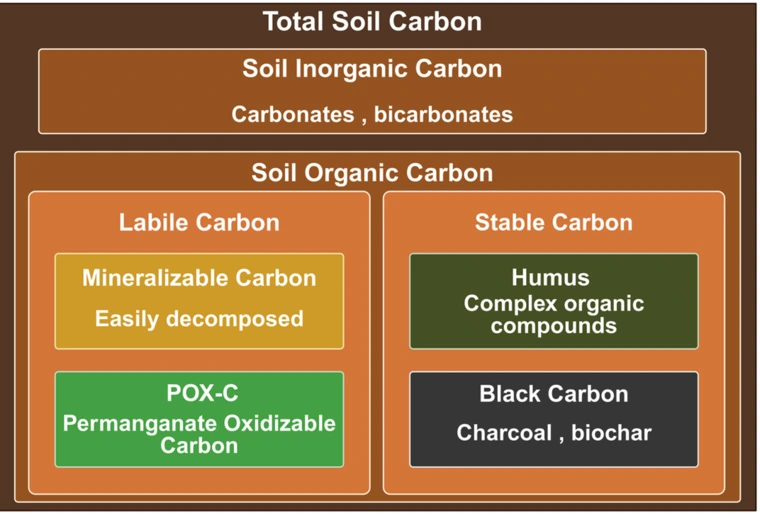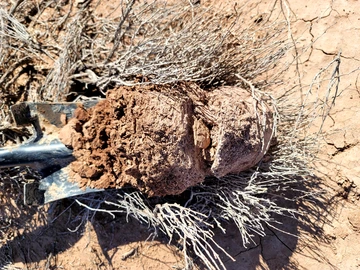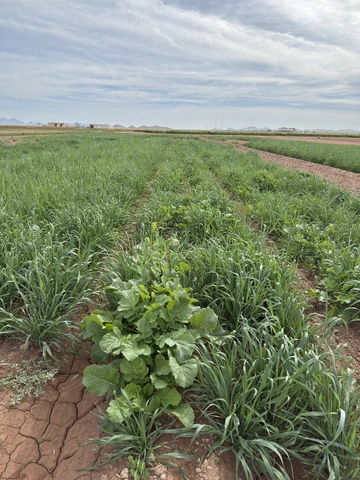Carbon, an essential element for life, is crucial in agriculture as it supports plant growth and maintains soil health. Soil microbes depend on carbon for energy, and as they decompose organic material (carbon mineralization) for carbon and nutrients. This process also returns nutrients to the soil and ecosystem and contributes to the global carbon cycle, potentially improving soil and ecosystem health.
Soil carbon is broadly divided into organic carbon and inorganic carbon: while soil organic carbon is essential for soil health and productivity, soil inorganic carbon forms such as calcium carbonate or caliche often present unique challenges to agriculture (Figure 1). Soil organic carbon has two primary categories: labile fractions that are easily accessible to most microbial communities, and stable fractions that are more complex, and it is resistant to decomposition by most microbial groups. POX-C is an abbreviation for Permanganate Oxidizable Carbon, which is a dynamic, labile component of total soil organic carbon (Figure 1). POX-C accounts for 2-6% of total soil organic carbon and acts as a readily available energy source for soil microorganisms1. Soil organic carbon as POX-C is highly associated with soil fertility as this labile organic carbon fraction, POX-C, is easily accessible to soil microbes and when decomposed, it releases essential plant nutrients (such as nitrogen, phosphorus, sulfur) tied up in soil organic matter. Higher levels of POX-C can promote microbial activity as most microbes can access this source of energy they require to reproduce and sustain in the soil. Therefore, managing carbon inputs is essential for maintaining soil health and improving agricultural sustainability1. Carbon inputs with higher POX-C and similar labile soil organic carbon contents (compost) influence soil microbes differently than carbon inputs with more stable sources of soil organic carbon (biochar).

Figure 1: POX-C is a small fraction of total soil carbon pool
Importance for agriculture sustainability
Although POX-C is a universally recognized soil health indicator, most commercial soil testing labs and agronomic consultancies are unaware of its significance and do not offer this test for growers. This article aims to explain POX-C for a wide range of stakeholders including agronomic consultants, Extension professionals, and most importantly commercial growers. POX-C is mostly made up of simpler organic molecules like carbohydrates and proteins, which serve as an important energy source for microbes2. These compounds connect POX-C to microbial function by enhancing vital microbial processes like carbon mineralization and nutrient cycling3. Moreover, increased POX-C levels promote microbial activity, which improves soil fertility, resilience, and structure4, making it an essential indicator of soil health and agricultural sustainability. As a rapid and accurate indicator of soil health, POX-C helps identify minute changes in soil carbon dynamics faster than assessments of total organic matter or organic carbon2. Agricultural management practices such as the addition of cover crops, organic amendments and reduced tillage can significantly increase POX-C levels, fostering soil vitality and sustainable productivity5. Overall, POX-C is very sensitive to any soil management activities and can help monitor soil health changes.
Role in building healthy desert soils
Desert ecosystems are characterized by extreme circumstances, such as high temperatures, minimal precipitation, and a lack of organic matter, resulting in soils with low POX-C and soil organic carbon (Figure 2). However, POX-C can provide valuable information about soil health and land management. Soil health surveys conducted by our team in Arizona reported soil organic carbon values ranging between 0.34 – 1.22 % (mean 0.88%) and POX-C values between 0 and 422 mg carbon/ kg soil (257 mg carbon/ kg soil)6. Increasing organic inputs with larger quantities of labile carbon, while minimizing soil disturbance can boost POX-C levels, improving soil stability, water retention, and microbial life, all of which are critical for maintaining soil health in arid situations. POX- C's high sensitivity to any changes in soil management practices makes it an important monitoring tool for desert soil health and an early predictor of soil improvement.
Acknowledgements
This project is partially funded by a grant from the USDA- NIFA Sustainable Agricultural Systems – Coordinated Agricultural Projects Program (Award #: 2024-68012- 41750) and several Specialty Crop Block Grants funded by Arizona Department of Agriculture SCBGP# 22-19, 22-27, and 23-21.
References
- Duval et al. (2018). Catena, 171, 316-326.
- Thoumazeau et al. (2020). Geoderma, 375, 114496.
- Hurisso et al. SSSAJ, 82(4), 939-948.
- Nyamasoka-Magonziwa et al. (2020). Geoderma, 376, 114539.
- Thapa et al. (2024). SSSAJ, 88.3 (2024): 730-744.
- Sanyal et al. (2022). UA Cooperative Extension Pub#AZ 2059.



